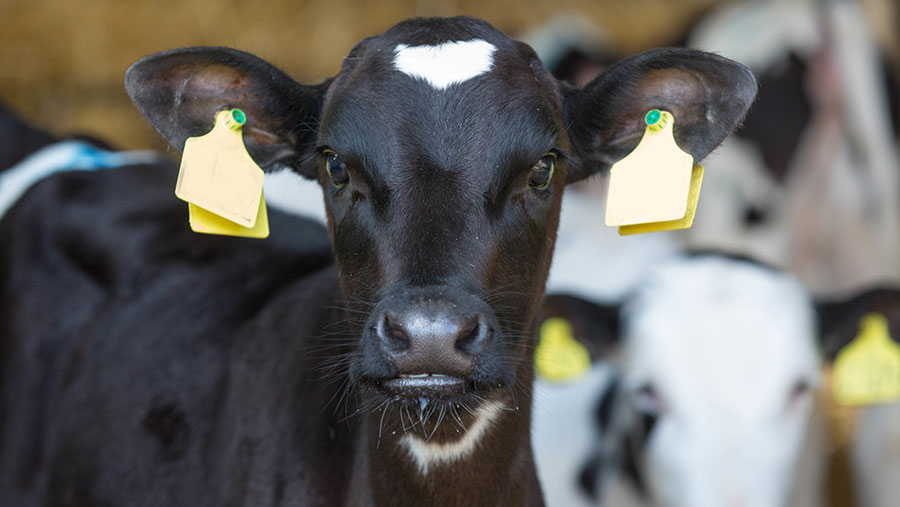6 things that can affect lifetime milk production
 © Tim Scrivener
© Tim Scrivener Calf-rearing protocols and the management of a calf’s dam can have a big influence on the productivity of a heifer once she starts milking.
Research into epigenetics – the study of prepartum nutrition, management and stress – has revealed the management of dry cows can have a far-reaching impact on their progeny, well beyond the post-calving period.
Speaking at Dairy Tech (7 February), Cargill’s calf and heifer rearing specialist Bianca Theeruth, highlighted a wealth of research to back this up.
See also: Video: Step-by-step guide to disbudding calves
Below we summarise the findings and Ms Theeruth explains how to overcome these bottlenecks.
1. The energy of dry cow diets
Gao et al (2012) investigated the effect of prepartum diets differing in energy density on growth performance and immunity of neonatal calves.
The study saw 30 Holstein dairy cows randomly allocated into one of three groups:
- low energy (net energy of lactation (NEL)) = 5.25 MJ/kg of dry matter
- medium energy (NEL) = 5.88 MJ/kg of dry matter
- and high energy (NEL) = 6.48 MJ/kg of dry matter at day 21 prepartum.
Results found calves born from cows fed low energy diets were lighter (-4.7kg) and shorter (-3.3cm) compared with those born from dams fed high-energy diets.
They also had reduced immune status (a lower percentage of lymphocyte markers found in white blood cells).
Action/takeaway message
- Net energy lactation – minimum 5.5MJ/kg and maximum 6.5MJ/kg
- Energy requirement during the dry period – far off group 90MJ/day and close up group up to 120MJ/day to support the growing calf (+/- 100MJ/day during the dry period)
2. Heat stress
A study carried out on five farms in Florida assessed the effects of heat stress in the last six weeks before calving in two groups of animals:
- One group was cooled using sprinklers, fans and shade
- The other group was only given access to shade
Milk production of their offspring was then compared during the first lactation. The study showed calves born from cooled cows gave more than 5kg more milk per day compared with those born from cows subjected to heat stress.
(Study carried out by Monteiro et al 2016)
Action/takeaway message:
- Cows exhibit mild heat stress with temperatures as low as 22C when the relative humidity is high (90%)
- Use fans, shade, sprinklers/showers; feed more during cooler periods (early morning and late afternoon); provide fresh feed in the bunker at regular intervals and remove heated feed; feed high-quality diet (produces less heat); and provide clean, cool drinking water
3. Calving difficulty
Calving difficulties can also be associated with lower milk production milk yields in first lactation.
Another study (Eaglen et al 2011) showed assisted calves produced 710kg less milk in accumulated 305-day yields than those not assisted.
“This demonstrates very well that you can’t negate the effects of a hard calving,” said Ms Theeruth.
Action/takeaway message:
- The period 60 days prior to calving has potential to be challenging for first calf heifers as they must successfully adapt to numerous physiological and behavioural changes
- Reducing the metabolic, psychological and pathogenic hurdles during the transition period is crucial
- Pre-calving feeding strategies should control energy intake, moderate body fat mobilisation at calving and optimise post-calving feed intake
4. Colostrum fed
Feeding high-quality colostrum in the first hour of life can also help boost productivity.
A US study by Faber et al 2005 compared the performance of Brown Swiss calves fed either 2 litres or 4 litres of maternal colostrum within an hour.
Results showed calves fed 4 litres:
- Had lower vet costs (-$15)
- Improved weight gain
- Reached calving two weeks earlier than the other group
- And produced, on average, 908kg more milk in their first 305-day lactation and 1,089kg more milk in their second, compared with the group fed less colostrum at birth.
“This goes to show that colostrum is so much more than providing immunity,” said Ms Theeruth.
Action/takeaway message
Colostrum management
- Quality immunoglobulins (IgG) in milk less than 50g/litre and IgG in blood = 15g/litre (less than 10g/litre)
- Quantity 2-4 litres or 10% bodyweight
- Quickly One to two hours or within six hours after birth
- Quietly Minimise stress to ensure efficient absorption of protective antibodies
- Cleanliness Bacterial count of < 100 000 colony-forming unit (cfu)/ml total plate count and faecal coliforms below 10 000 cfu/ml
5. Disease
Health is also paramount.
Each day a pre-weaned calf was ill with scours or coughing resulted in a 126kg of ME in milk produced in the first lactation, a study, by Heinrichs and Heinrichs in 2011 assessing 795 Holstein calves from 21 dairies in Pennsylvania, found.
Action/takeaway message
- Keep calving pen clean
- Minimise environmental challenges as stress inhibits immune system
- Adhere to high biosecurity and hygiene protocols
- Provide a dry, draught-free, well-ventilated area and bed up regularly
6. Pre-weaning nutrition
Weight gain pre-weaning also has an effect on milk production.
The Heinrichs and Heinrichs study also showed for every increase of 1kg in dry matter intake at weaning there was an increase of 286.7kg of ME milk produced in the first lactation.
Action/takeaway message:
- Calf starter should be 18% protein, 3-4% oil, ash less than 8%, fibre 8-10%, starch and sugar 20–25 %, neutral detergent fibre 20%
- Milk replacer should be a minimum 20% protein and traditional levels in industry are 22 to 23% with as high as 26% designed for rearing replacement heifers to develop frame and lean muscle deposition
- Calves should double their birthweight by 56 days.
